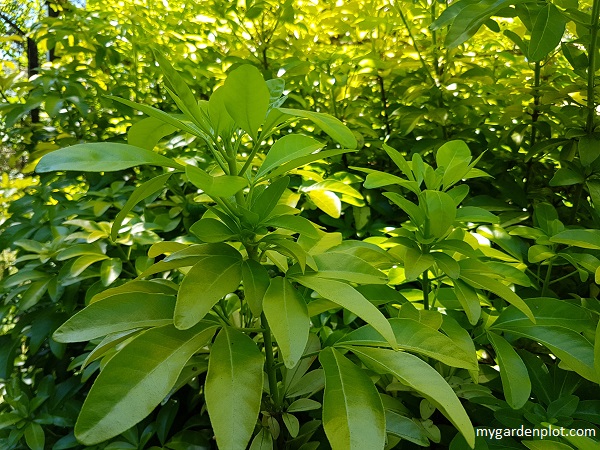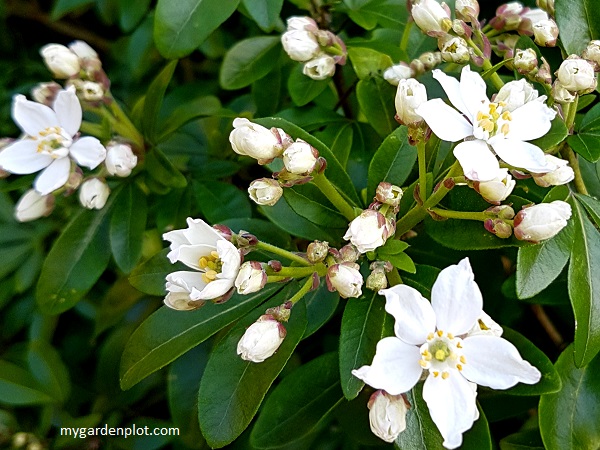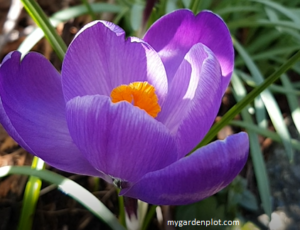About Choisya ternate: Mexican Orange Blossom, Mexican Mock Orange
The Choisya ternate, also referred to as Mexican orange blossom or Mexican mock orange, is a flowering, evergreen shrub native to Mexico and the southwest USA. This hardy plant blooms in spring and often again in mid-autumn. The cluster of white star-shaped flowers are fragrant with a sweet orange scent – even the foliage releases a fragrance when crushed. It belongs to the Rutaceae family, which includes citrus plants, explaining its citrus-like scent. The Choisya shrub thrives in the Pacific Northwest coast. Although choisya is, for the most part, frost resistant, it can suffer from intense or prolonged cold weather.
While the flowers bloom profusely in late spring, a second, lighter flush may occur in late summer or autumn. The blooms attract pollinators like bees.
The choisya is valued for its year-round interest of evergreen golden or green foliage. But it also favoured for its adaptability and low maintenance. It has an attractive dome or rounded habit that can be easily pruned and fairly drought tolerant once established. The choisya just about fits in with most garden designs, either as a specimen plant, backdrop in a mixed border or grouped for hedging. It is also suitable for patio planters. Its fragrance makes it perfect near patios or pathways.
Popular choisya cultivars include the ‘Aztec Pearl’, which has a neat, rounded form and flowers for more than a month. The ‘Aztec Pearl’ is hardy to -15C (5F). Another favourite is the ‘Sundance’ with bright golden yellow leaves – though less hardy and susceptible to frost damage.
The Mexican orange blossom is non-toxic and safe for pet-friendly gardens.
This versatile, low-care and attractive evergreen shrub is celebrated for its fragrant flowers and aromatic foliage. By following these guidelines on how to grow and prune, your Choisya will reward you with fragrant blooms and lush foliage, enhancing your garden’s appeal year-round.
Choisya (Mexican Orange Blossom) At A Glance
Type: Evergreen
Location: Full Sun / Partial Shade (yellow-leaved varieties may scorch in intense sun)
Flowers: Spring (possibly again in late summer or autumn)
When To Prune: Prune after flowering (late spring/early summer) to shape and encourage bushiness
Size: Generally 1.8 metres (6 ft) in height and spread (compact cultivars like ‘Aztec Pearl’ stay smaller)
Zones: 7, 8, 9, 10 (hardiness to temperatures as low as -12C (10F) but less hardy varieties like ‘Sundance’ will need protection from harsh winds and frost in cooler zones)
Where to Plant and How to Grow Choisya (Mexican Orange Blossom)
Plant in spring or autumn in fertile, well-drained soil. Tolerates various soil types (clay, loam, sandy) if drainage is good. Slightly acidic to neutral pH is ideal. Water regularly, especially the first year. Drought-tolerant once established but dislikes waterlogged roots. Water deeply once a week during prolonged hot dry spells.
Dig a hole twice the width of the root ball. Mix in compost with native soil. Plant at the same depth as the container. Space 3-5 feet apart, depending on variety size.
It tolerates partial shade, but those that receive full sun have greater flower yield. Ideally an east-facing sunny location with afternoon shade from hot summer sun will protect it from being scorched.
For winter care apply mulch around the base to insulate roots in colder areas. If the location is in the path of bitterly cold winds during winter, it may need some burlap protection, or reconsider planting it in a more sheltered spot. Use horticultural fleece during frosts, especially for young plants.
The choisya benefits from a balanced slow-release fertilizer applied in early spring. And mulch added in spring helps to conserve moisture.
Propagation is possible by taking semi-hardwood cuttings in late summer. Root in well-draining soil with rooting hormone.
The Mexican orange blossom requires minimal care once established.
When and How to Prune Choisya (Mexican Orange Blossom)
The choisya shrub can grow upwards to 1.8 metres (6 feet) and sometimes a little more, but don’t let this scare you. Choisyas tolerate pruning from a light trim to a hard prune. Shape lightly to maintain form, cutting back leggy stems. Avoid heavy pruning into old wood to preserve future blooms for the next season.
Pruning choisya annually in spring is beneficial for new growth and to keep an attractive shape. Hard pruning to restore the form of a neglected shrub or contain the shrub’s size should be done after the last hard frost. And always remove any dead or damaged stems caused during winter. Ensure good airflow by also removing any crossing branches.
Young plants should be pruned to one-third in the spring. This encourages new shoots to grow from base to form a bushy and denser habit as it grows.
Mature choisya shrubs should be pruned after flowering to keep a uniformed rounded form. If your plants develop bare or straggly stems, cut back all the main stems back to about 20-25 cm (8-10 inches) from the ground in the spring once the risk of frost is gone. Prune after the main spring bloom (late spring/early summer). Lightly trim again after a potential autumn flush.
Trim off the faded flowers in late spring by cutting just below the flowerheads. This can encourage a second batch of blooms in autumn.
Tools Needed for Pruning Choisya (Mexican Orange Blossom)
Below is the list of essential tools needed to prune a Mexican orange blossom shrub. You will likely only need to have a good quality sharp pruner to maintain the shape of Mexican orange blossom. With mature shrubs, the older wood that needs to be cut from the base may be thick and a lopper will be needed.
- Pruners
- Long-handled loppers
- Garden gloves
RELATED TOPIC: Buyer’s Guide How To Choose Garden Hand Pruners (Secateurs)

Pests, Diseases and Troubleshooting
The Mexican Orange Blossom has minimal pest issues; occasional aphids, scale, or spider mites. Treat with insecticidal soap or neem oil if available in your area.
Sparse flowers is likely due to insufficient sunlight. More sun enhances flowering. Relocate if necessary. Over-fertilizing can also reduce flowering.
Avoid overwatering to prevent root rot.
Yellow leaves usually indicate overwatering or poor drainage. Check soil moisture. Leaf drop may result from extreme cold or excessive shade. Variegated varieties (for example, ‘Sundance’) benefit from afternoon shade to prevent leaf scorch.
Choisya shrubs are generally rabbit and deer resistant. Though fawns that pass through our garden may try the young leaves from one particular Mexican orange shrub. We guess it is not that tasty after all as they generally leave it after that first nibble. We have been tempted to move it, but it is generally a short-lived issue – maybe we can put it down a ‘teachable’ moment for fawns!
Popular Varieties
Mexican Orange Blossom combines ornamental appeal with resilience, making it a garden favorite for year-round interest and sensory delight. Its citrusy fragrance and ease of growth contribute to its popularity in diverse garden styles.
Recommended varieties include:
- ‘Sundance’: Golden foliage, best in partial shade and brightens shady spots
- ‘Aztec Pearl’: Finely divided leaves, pink buds, and a more compact form
- ‘White Dazzler’: Variegated foliage and prolific blooms






